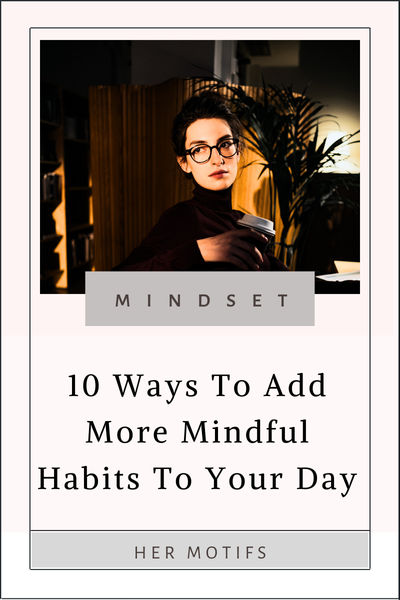10 Ways a Positive Mindset Can Overcome Anxiety
 A positive mindset can help to lessen at best overcome anxiety.
A positive mindset can help to lessen at best overcome anxiety.
Anxiety can be a debilitating mental condition that can make even the simplest of tasks feel like a huge challenge.
It can lead to stress, worry, and panic attacks that can affect one’s daily life.
While medication and therapy can help manage anxiety, cultivating a positive mindset can also play a significant role in reducing anxiety symptoms.
One of the best practices is to maintain a healthy mindset. There are many ways to introduce daily positive habits or actions that can refocus your mind, thoughts and ultimately your behavior.
Techniques like deep breathing, visualization, and mindfulness can instill a sense of calm and control, effectively countering anxiety’s disruptive influence. The power of a positive mindset lies in its capacity to reframe challenges as opportunities for growth, ultimately fostering resilience and allowing individuals to overcome anxiety’s hold on their lives with newfound strength and optimism. In this blog post, we embark on a journey of exploration, delving into the intricate relationship between mindset and anxiety. We’ll uncover a multitude of strategies, techniques, and perspectives that showcase how a positive mindset can serve as a formidable ally in the battle against anxiety. From cognitive reframing and mindfulness practices to the cultivation of self-compassion and resilience, these approaches offer actionable steps to transform anxiety into an opportunity for growth, healing, and empowerment
.
..
Table of Contents
Tools to Overcome Anxiety
Whether you’re grappling with occasional anxiety or facing a more chronic condition, let’s delve into the realm of positive psychology, where the mind’s innate strength can transcend the challenges of anxiety, fostering a life of tranquility, resilience, and hope, below are some tools
.
 CBT + DBT + ACT
CBT + DBT + ACT
CBT + DBT + ACT is a comprehensive guide to the most effective psychotherapies available nowadays
- Explains 6 phases of the CBT framework
- Helps with many behavioral and thoughts
- Many practical step-by-step exercises
- 12 vagus nerve stimulation techniques
- How To rewire your mind to experience
.
 The Anxiety Worry Workbook
The Anxiety Worry Workbook
The proven treatment approach developed and tested over decades by pioneering clinician-researcher Aaron T. Beck
- Carefully crafted worksheets
- Clear exercises, and examples
- practical strategies for identifying anxiety triggers
- challenging the thoughts and beliefs that lead to distress
- Include other triggers and solution for panic attacks, social anxiety
.
 Anxiety Skills Workbook
Anxiety Skills Workbook
Simple CBT and Mindfulness Strategies for Overcoming Anxiety, Fear, and Worry
- Collection of simple treatment strategies
- Tips and tricks for managing your anxiety and mindfulness
- Helps focus on your own individual anxiety and worry patterns
- Easy to follow cognitive behavioral therapy (CBT) and mindfulness
.
 The CBT Toolbox
The CBT Toolbox
Bestselling CBT Toolbox, Cognitive Behavioral Therapy expert Dr. Jeff Riggenbach translates 20 years of practice and training
- 185 exercises and activities that are reproducible and ready-to-go for in-session, homework, or your own self-improvement, dealing with difficult
- Exercises for depression, anxiety, anger problem solving
- Exercises overcoming daily obstacles, addictive behaviors, stress, goal setting, time management and more
.
 Fidget Finger Toy
Fidget Finger Toy
Foldable Infinity Cube is composed of eight small cubes
- Great for stress and anxiety relief
- Durable sensory gift
- Each cube can be rotated from any direction and angle
- Hold in one hand and make in any shape you like
.
1. Focus on the Present Moment
Anxiety often stems from worrying about the future or dwelling on the past. One way to overcome anxiety is to focus on the present moment. Practicing mindfulness techniques such as deep breathing, meditation, and yoga can help you stay in the present moment and reduce anxious thoughts.
Focusing on the present moment, also known as mindfulness, involves being fully present and engaged in the current experience without judgment. Here are four examples of how to focus on the present moment:
- Mindful Breathing: Take a few deep breaths and focus on the sensations of your breath as it enters and leaves your body. If your mind starts to wander, gently bring it back to your breath.
- Sensory Awareness: Focus on what you can see, hear, feel, taste, and smell in the present moment. Engage your senses and try to fully experience your surroundings.
- Mindful Eating: Pay attention to the taste, texture, and smell of the food you’re eating. Take your time and savor each bite, without distractions such as TV or your phone.
- Body Scan Meditation: Lie down or sit comfortably and focus your attention on each part of your body, starting from your toes and moving up to your head. Notice any sensations without judgment or interpretation.
.
2. Practice Self-Care
Self-care is vital for maintaining good mental health. Taking care of yourself can help reduce stress and anxiety levels and help get rid or manage anxiety. Make time for activities that make you happy, such as reading a book, taking a relaxing bath, or going for a walk in nature.
Self-care is essential for overall well-being and involves taking care of oneself physically, emotionally, and mentally. Here are four examples of self-care practices:
- Taking a relaxing bath: A hot bath with essential oils or Epsom salt can help relax muscles, reduce stress and anxiety, and improve sleep.
- Engaging in physical exercise: Regular exercise can improve physical and mental health, boost self-confidence, and reduce stress levels.
- Meditation: Practicing meditation can help calm the mind, reduce stress and anxiety, and improve overall emotional well-being.
- Spending time in nature: Spending time in nature, such as going for a hike or walking in a park, can improve mood, reduce stress, and promote feelings of peace and well-being.
.
3. Keep a Gratitude Journal
When you’re anxious, it’s easy to focus on the negative aspects of life. However, focusing on the positive can help shift your mindset and reduce anxiety levels. Keeping a gratitude journal or daily affirmations is a powerful tool to cultivate a positive mindset. It involves writing down things that you are thankful for each day. Here are four examples of what you can include in your gratitude journal:
- Write about the people in your life that you are grateful for: This could be your family, friends, or colleagues. Write down why you appreciate them and how they have impacted your life.
- Be thankful for the small things: It’s easy to take the small things in life for granted. Take a moment to appreciate the little things that bring you joy, such as a warm cup of tea, a good book, or a sunny day.
- Reflect on accomplishments: Think about the things you have achieved, big or small, and write them down. This can be a great confidence booster and a reminder of what you are capable of.
- Appreciate challenges and setbacks: Instead of dwelling on the negative, try to find the positive in difficult situations. Reflect on how challenges have helped you grow and what you have learned from them.
.
4. Challenge Negative Thoughts
Anxiety often leads to negative thinking patterns. It’s essential to challenge these negative thoughts and replace them with positive and abundant mindset. When you catch yourself thinking negatively, ask yourself if there’s any evidence to support that thought. If there isn’t, try to replace it with a positive thought. Challenging negative thoughts is an effective way to shift our mindset towards a more positive and optimistic outlook. Here are four examples of how to challenge negative thoughts:
- Identify the negative thought: The first step in challenging negative thoughts is to become aware of them. Write down your negative thoughts as they arise and examine them objectively.
- Question the evidence: Ask yourself if there is any evidence to support your negative thought. Often, we assume the worst without any real evidence to back it up.
- Consider alternative explanations: Try to come up with alternative explanations for the situation that don’t involve negative thinking. What else could be going on?
- Reframe the thought: Once you’ve examined the negative thought and challenged it with evidence and alternative explanations, try to reframe it in a more positive light. For example, if you find yourself thinking, “I’m not good enough,” reframe it to “I may not be perfect, but I’m doing the best I can.”
.
5. Practice Positive Self-Talk
The way we talk to ourselves can have a significant impact on our mental health. Practicing positive self-talk can help shift your mindset and reduce anxiety levels. Instead of criticizing yourself, try to encourage yourself and focus on your strengths. Practicing positive self-talk involves replacing negative thoughts or self-talk with positive and encouraging statements. Here are some examples:
- Instead of saying “I can’t do this,” say “I will do my best and keep trying until I succeed.”
- Instead of saying “I’m not good enough,” say “I am worthy and capable of achieving my goals.”
- Instead of saying “I always mess things up,” say “I am not perfect, but I am constantly learning and improving.”
- Instead of saying “I’m a failure,” say “I have faced challenges before and overcome them, I will do the same this time.”
.
6. Stay Active
Exercise is an excellent way to reduce anxiety levels. It releases endorphins, which are natural mood boosters. Regular exercise can help you feel more relaxed and reduce feelings of anxiety. Staying active is an important aspect of leading a healthy lifestyle, and it also has many benefits for improving one’s mindset. Here are four examples of how to stay active:
- Going for a daily walk or jog: Even a 20-minute walk or jog around your neighborhood can help boost your mood and energy levels.
- Practicing yoga or meditation: Yoga and meditation are great ways to stay active and promote mindfulness, which can help reduce stress and anxiety.
- Trying new workouts: Trying out new workouts, such as dance classes, martial arts, or strength training, can help you stay motivated and engaged in physical activity.
- Engaging in outdoor activities: Hiking, swimming, kayaking, or cycling are great ways to stay active and enjoy the great outdoors, which can have a positive impact on your mental health and well-being.
.
7. Connect with Others
Isolation can worsen anxiety symptoms. It’s essential to connect with others, whether it’s through socializing or seeking support from loved ones. Talking to someone can help you process your thoughts and feelings and provide you with a different perspective on your situation. Connecting with others is an important aspect of maintaining mental well-being. Here are four examples of ways to connect with others:
- Schedule regular catch-ups with friends or family members over the phone or video call, especially if you are unable to meet them in person.
- Join a club or group that interests you, such as a book club or hiking group. This can provide a sense of belonging and shared interests.
- Volunteer for a cause you are passionate about. This can provide a sense of purpose and allow you to connect with like-minded individuals.
- Attend social events or parties, such as birthday parties or dinner parties, where you can meet new people and socialize in a relaxed and enjoyable atmosphere.
.
8. Set Realistic Goals
Setting goals can help you feel more in control of your life, but it’s essential to set realistic goals. Setting unrealistic goals can lead to feelings of failure and increase anxiety levels. Focus on setting achievable goals that can help you feel accomplished. The power of setting realistic goals is an important aspect of personal growth and mindset improvement. Here are four examples of setting realistic goals:
- Professional Goals: Setting a goal to get a promotion within the next six months is an example of a realistic professional goal. This goal can be achieved by working hard, acquiring new skills, and networking.
- Fitness Goals: Setting a goal to lose 10 pounds in three months is an example of a realistic fitness goal. This goal can be achieved by following a healthy diet and exercise routine.
- Personal Goals: Setting a goal to read one book per month is an example of a realistic personal goal. This goal can be achieved by setting aside time to read every day.
- Financial Goals: Setting a goal to save $500 every month is an example of a realistic financial goal. This goal can be achieved by creating a budget, reducing expenses, and increasing income.
.
9. Learn to Say No
Saying no is an essential part of self-care. It’s okay to prioritize your mental health and decline invitations or tasks that can add to your anxiety levels. Set boundaries and learn to say no to things that don’t align with your values or goals. Learning to say no is an important aspect of maintaining healthy boundaries and taking care of oneself. Here are four examples of how to say no:
- A friend asks you to take on a big project with them, but you already have a lot on your plate. Instead of agreeing to take it on, you could say something like, “I appreciate the offer, but I’m already at capacity with my current projects.”
- A family member wants to borrow money from you, but you’re not comfortable lending it out. You could respond with something like, “I’m sorry, but I’m not in a position to lend money right now.”
- A co-worker asks you to cover their shift on a day you had planned to take off. You could say something like, “I wish I could help you out, but I have plans that day and won’t be able to cover your shift.”
- Someone invites you to a social event, but you’re feeling overwhelmed and need some time to yourself. You could say something like, “Thanks for the invitation, but I need to take some time for myself right now.”
.
10. Seek Professional Help
While a positive mindset can help overcome anxiety, sometimes professional help is necessary. If your anxiety is severe or affecting your daily life, seeking help from a mental health professional can provide you with the necessary tools and support to overcome it. Seeking professional help can be a crucial step in improving one’s mental health and overall wellbeing. Here are four examples of seeking professional help:
- Therapy or Counseling: Talking to a licensed therapist or counselor can be a great way to address mental health issues such as depression, anxiety, or trauma. A therapist can help you work through your thoughts and feelings, develop coping strategies, and make positive changes in your life.
- Medical Treatment: Sometimes, mental health issues require medical treatment such as medication or other interventions. Seeking the help of a mental health professional, such as a psychiatrist or psychiatric nurse practitioner, can be key in managing symptoms and improving overall quality of life.
- Support Groups: Joining a support group can provide a sense of community and connection with others who may be experiencing similar challenges. Support groups can be found for a variety of mental health issues and can be a great resource for finding hope and support.
- Life Coach: Working with a life coach can be a helpful way to gain clarity and direction in your life. A life coach can help you set and achieve goals, improve time management, and develop strategies for success.
Conclusion
In conclusion, a positive mindset can be a powerful tool in overcoming anxiety. By practicing self-care, focusing on the present moment, challenging negative thoughts, and staying active, you can develop a positive mindset that can help you manage anxiety symptoms. Remember to seek professional help if your anxiety is severe or affecting your daily life.
.
- 100 Valentine Lovers Questions - February 24, 2025
- 2025 New Year Growth Quotes - February 24, 2025
- 2025 Inspiring Self Love Quotes - February 24, 2025







